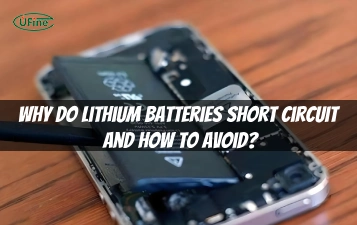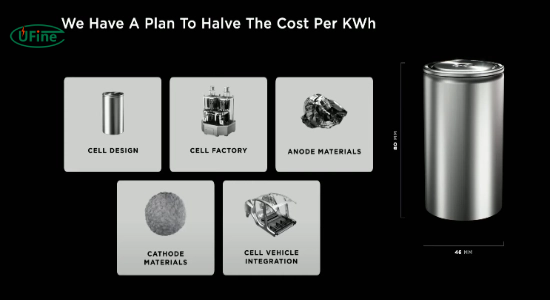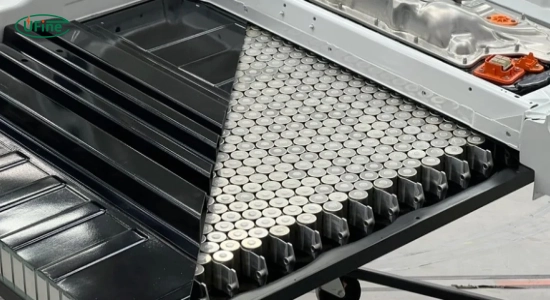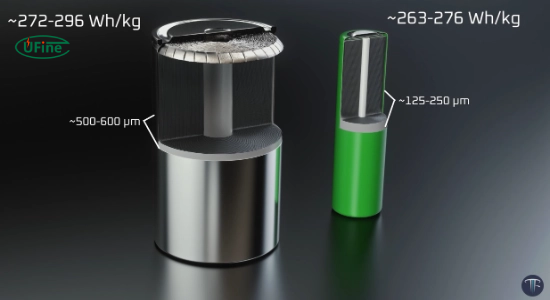
- Part 1. What is the Tesla 4680 battery?
- Part 2. Materials used in Tesla 4680 cell battery
- Part 3. What makes the Tesla 4680 battery unique compared to other EV batteries?
- Part 4. How does Tesla's dry electrode technology improve battery performance?
- Part 5. How does the Tesla 4680 battery's design contribute to its fire prevention?
- Part 6. What causes battery fires?
- Part 7. Are there any regulations governing EV batteries?
- Part 8. What are common misconceptions about EV fires?
- Part 9. How do Tesla's competitors approach battery safety?
- Part 10. How does insurance play a role in EV safety?
- Part 11. FAQs
When considering the safety of electric vehicles (EVs), a common question arises: how likely is the Tesla 4680 battery to combust? This question is crucial for potential buyers and current owners, as battery safety is a significant concern in the EV market. The Tesla 4680 battery is a groundbreaking innovation that promises enhanced performance and safety features, but understanding its combustion risks is essential for peace of mind.
In this article, we will delve into the composition of the 4680 battery, its unique features, and how it compares to traditional batteries. We will also discuss the materials used in the Tesla 4680 cell battery and explore how design elements contribute to fire prevention.
Part 1. What is the Tesla 4680 battery?
The Tesla 4680 battery is a cylindrical lithium-ion battery that represents a significant advancement in battery technology for electric vehicles. Named after its dimensions—46mm in diameter and 80mm in height—this battery is designed to be more efficient and cost-effective than previous models.
Key Features of the 4680 Battery
- Higher Energy Density: The 4680 battery offers a higher energy density, meaning it can store more energy in a compact space. This improvement leads to longer ranges for Tesla vehicles, allowing drivers to travel further on a single charge.
- Cost Reduction: Tesla aims to reduce production costs by approximately 20% with this new battery technology. This reduction is vital for making EVs more affordable for consumers, helping to drive broader adoption.
- Dry Electrode Technology: One of the 4680 battery’s most exciting aspects is its use of dry electrode technology. This innovation allows for faster manufacturing processes and reduces material waste during production, making it more environmentally friendly.
[4680 Battery Guide] Large Cell + Tabless + Dry Battery Technology
Part 2. Materials used in Tesla 4680 cell battery
The materials used in the Tesla 4680 cell battery play a crucial role in its performance and safety.
Composition of the Battery
Lithium: As the primary component, lithium provides high energy density and efficiency for charging and discharging cycles.
- Nickel: Nickel enhances energy capacity, allowing for longer driving ranges while maintaining performance.
- Cobalt: Although used in smaller quantities, cobalt helps stabilize the battery chemistry and improve longevity.
- Graphite: Used in the anode, graphite aids in efficient electron flow during charging and discharging processes.
These materials are carefully selected not only for their performance characteristics but also for their ability to minimize risks associated with combustion.
Part 3. What makes the Tesla 4680 battery unique compared to other EV batteries?
The Tesla 4680 battery stands out from other EV batteries due to several unique features:
Larger Cell Size
The larger size of the cells allows for fewer connections between cells, reducing resistance and improving overall efficiency. This design change leads to better thermal management and reduces heat generation during operation.
Integrated Design
Tesla has integrated various components within the cell structure itself. This integration simplifies manufacturing processes while enhancing energy density and thermal stability performance metrics.
Improved Cooling Systems
The design includes advanced cooling systems that help maintain optimal operating temperatures. By effectively managing heat, these systems reduce the risk of thermal runaway, which can lead to combustion.
Part 4. How does Tesla’s dry electrode technology improve battery performance?
Tesla’s dry electrode technology is a game-changer in battery manufacturing:
Faster Production Times
This technology eliminates the need for solvents during production, significantly speeding up manufacturing times. Faster production means Tesla can scale its operations more efficiently to meet growing demand.
Enhanced Energy Density
By using dry electrodes, Tesla can create thinner layers within the cells. Thinner layers increase surface area contact between materials, enhancing energy density and overall performance.
Reduced Environmental Impact
The elimination of solvents not only speeds up production but also reduces waste generated during manufacturing. This environmentally friendly approach aligns with Tesla’s commitment to sustainability and responsible resource usage.
Part 5. How does the Tesla 4680 battery’s design contribute to its fire prevention?
The design of the Tesla 4680 battery incorporates several features aimed at minimizing fire risks:
Structural Improvements
- Deformable Cells: The cells are designed to absorb impact forces better than traditional batteries. This feature is crucial during collisions as it helps prevent damage that could lead to combustion.
- Gas Venting Mechanism: In case of damage, the battery includes a mechanism that allows gas buildup to escape safely, reducing the risk of thermal runaway—a condition that can lead to fires.
Advanced Battery Management Systems (BMS)
Tesla’s BMS continuously monitors each cell’s voltage and temperature, ensuring they operate within safe limits. This system can detect abnormalities early and take corrective actions if necessary.
Rigorous Testing Protocols
Before any vehicle reaches consumers, it undergoes extensive testing under various conditions, including crash tests explicitly designed to assess how well the batteries hold up during accidents.
Part 6. What causes battery fires?
Understanding what leads to battery fires is essential for assessing the safety of any battery technology:
Thermal Runaway
Thermal runaway occurs when a cell’s temperature rises uncontrollably due to internal short circuits or external damage. For lithium-ion batteries, this can happen if:
- The battery exceeds temperatures around 150 degrees Celsius (302 degrees Fahrenheit).
- There is physical damage that compromises cell integrity.
External Factors
While internal factors play a role, external conditions can also contribute to fire risks:
- Collisions or punctures can lead to short circuits.
- Poor maintenance or defective components in ICE vehicles often cause fires due to fuel leaks or electrical failures.
Part 7. Are there any regulations governing EV batteries?
Regulatory bodies worldwide are beginning to implement stricter guidelines for EV batteries:
Safety Standards
Organizations such as the National Highway Traffic Safety Administration (NHTSA) have established standards manufacturers must meet regarding battery safety and performance.
Environmental Regulations
As concerns about sustainability grow, regulations surrounding battery recycling and disposal are becoming increasingly important. Manufacturers must ensure their batteries are safe and environmentally friendly throughout their lifecycle.
Part 8. What are common misconceptions about EV fires?
Despite statistics showing that EVs are generally safer from fires compared to traditional vehicles, misconceptions persist:
Misconception #1: EVs Catch Fire More Often
- Many believe EVs catch fire more frequently due to sensationalized media coverage. ICE vehicles are statistically more prone to fires because they rely on combustible fuels.
Misconception #2: All EV Fires Are Explosive
- While lithium-ion batteries can be challenging to extinguish once ignited, they do not explode like gasoline fires. The fire dynamics differ significantly between fuel-based and electric vehicles.
Part 9. How do Tesla’s competitors approach battery safety?
Other manufacturers have also made strides in enhancing battery safety:
General Motors (GM)
GM has adopted similar safety measures in their EVs by implementing robust thermal management systems and conducting rigorous crash testing.
Ford
Ford has focused on improving the thermal stability of its lithium-ion batteries through innovative cooling technologies designed to prevent overheating during operation.
Part 10. How does insurance play a role in EV safety?
Insurance companies are increasingly considering fire risk statistics when determining premiums for electric vehicles:
- Due to lower fire rates in EVs, many insurance providers offer reduced premiums for electric car owners.
- As data continues to support the safety of EVs over ICE vehicles, we may see broader acceptance and lower costs associated with insuring electric cars.
Part 11. FAQs
-
Are Tesla batteries prone to catching fire?
No, Tesla batteries are less likely to catch fire than ICE vehicles due to advanced safety features and design improvements. -
What causes an electric vehicle battery to fire?
Battery fires can occur due to thermal runaway caused by internal short circuits or external damage from collisions. -
How does Tesla ensure the safety of its batteries?
Tesla employs sophisticated Battery Management Systems (BMS) and extensively tests its vehicles before selling them to consumers. -
Is it true that all EV fires make headlines?
Yes, media coverage focuses on dramatic incidents involving EVs while neglecting more common ICE vehicle fires. -
What future advancements can we expect in EV battery technology?
Future advancements may include solid-state batteries and alternative chemistries that enhance performance and safety profiles.
Related Tags:
More Articles

What Is the Lithium Battery Short Circuit?
What is the lithium battery short circuit? To understand a lithium battery short circuit, we first need to understand how the battery works.
What is the Difference Between Silver Zinc Battery vs. Lithium-ion Rechargeable?
Compare silver zinc and lithium-ion rechargeable batteries: energy density, cycle life, safety, cost, and uses in drones, medical devices, EVs, and electronics.
What are Watts and Watt Hours in Battery?
Understand watt vs watt-hour in batteries: key differences, how to calculate capacity, and why they matter. Includes free comparison table.
Best 10 Blood Pressure Monitor Battery Review: Finding the Most Reliable
Are you looking for a reliable Blood Pressure Monitor battery? Here is a complete guide with the top 10 best blood pressure monitor batteries.
Bluetooth Headphone Battery Guide: All You Need to Know
Maximize headphone battery life with expert tips! Learn how to charge, check, troubleshoot, and choose the best bluetooth headphone battery in 2025.






